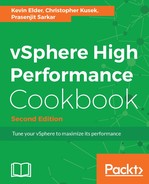The VMkernel core data mover has traditionally done software data movement. Now, with the hardware primitives in place, the data mover can use these primitives to offload certain operations to the array. When a data movement operation is invoked and the corresponding hardware offload operation is enabled, the data mover will first attempt to use the hardware offload. If the hardware offload operation fails, the data mover will fall back to the traditional software method of data movement.
If using the hardware offload does succeed, the hardware data movement should perform significantly better than the software data movement. It should consume fewer CPU cycles and less bandwidth on the fabric. Improvements in performance can be observed by timing operations that use these primitives and esxtop to track values such as CMDS/s, READS/s, WRITES/s, MBREAD/s, and MBWRTN/s of storage adapters during the operation.
VMFS uses the data mover to handle certain data operations. One application that invokes these operations is disklib. It is in turn used by utilities such as vmkfstools and hostd to manipulate the VM disks.
Now you may ask what those operations are where it will be leveraged. The following functionality leverages VMFS data movement services:
- Creating a full clone of a VM
- Importing a VMDK using vmkfstools –i
- Importing a VM or provisioning a VM of a VM template in vSphere Client
- Creating eagerzeroedthick disks via vmkfstools or by provisioning a VM
- Storage VMotion of a VM
- Committing redo logs or when snapshots and linked, clones are deleted
